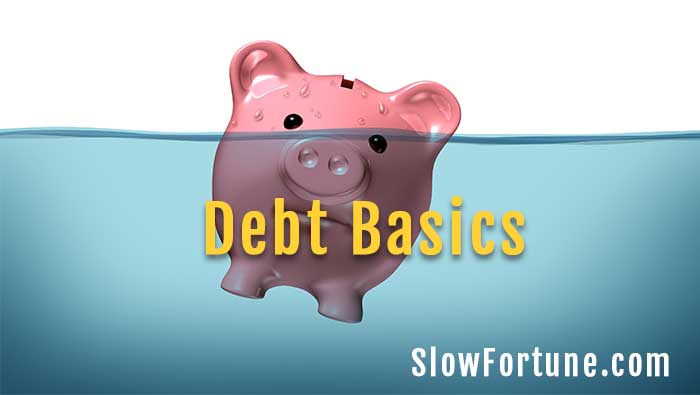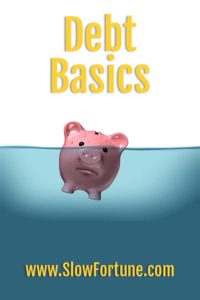
Debt Basics
 I used to assume that people understood debt basics – how debt worked, then I realised that many didn’t. So I’ve put together this article to introduce you to the main concepts of debt and help you understand how to best manage it.
I used to assume that people understood debt basics – how debt worked, then I realised that many didn’t. So I’ve put together this article to introduce you to the main concepts of debt and help you understand how to best manage it.
Let’s start by covering some of the basic terms.
Debt Basics
The amount you borrow is called the loan principal. In the case of a credit card, the principal of the debt would be the balance that’s owing currently.
The interest rate is the amount of interest you’re being charged on the debt. Usually, this increases in line with the perceived risk of the debt. A home loan is usually secured against the property being purchased. The bank can always sell the home to repay the debt, so this is considered a low-risk loan and consequently, the interest rate will be lower.
A car loan is a higher risk loan. Some can be secured loans, using the car as security. This still provides risk to the lender, because cars can depreciate at a high rate, so if the lender needed to sell the car to repay the loan, there may be a shortfall. A higher risk option is an unsecured car loan where there’s no security in place. This will always have a higher rate of interest than a secured car loan.
A credit card is usually at a much higher rate. Here in Australia, rates are currently around 20% on a credit card. This reflects the higher risk the banks attribute to credit cards. It’s also because credit cards are an effective way to access debt, so the banks will charge you via a higher interest rate for being able to access the credit.
Interest is usually applied against the balance outstanding. Here’s a very simple example:
Your loan principal is $10,000 and the interest rate is 10%. To calculate your monthly interest amount, you multiply $10,000 by 10% and then divide the answer by 12 (because there are 12 months in a year). In this case it would be $1,000 / 12 = $83.33.
You’d be charged $83.33 for a month’s interest.
In practice it’s a little more complicated than this – repayments made during the month will mean the balance is different on different days and there’s also the issue that some months have 30 days and some 31 (and one 28 days!). So for a lot of loans, the interest is calculated on the balance every day and accrues over the course of a month before it’s charged.
Interest is the price you pay for borrowing money. I’ve often said it’s like renting money – you pay rent to be able to use someone else’s money. The longer it takes you to repay your loan, the more interest you’ll pay.
If we looked at that $10,000 loan example, the monthly interest cost would be $83.33 so if you only paid payments of $83.33 per month to the loan, you’d never reduce the capital and you’d pay interest forever.
Some loans have a fixed term so repayments are calculated evenly over that term. If you borrowed $10,000 over a 5-year term at an interest rate of 10%, you’d make monthly repayments of $212.
In the first month, $83.33 of that $212 would go towards paying the interest and the remaining $128.67 would reduce the principal.
Next month the interest is calculated on a lower balance of $9,871.33 ($10,000 – $128.67) instead of $10,000. Your interest cost for the next month would be $82.26 – it’s based on 10% of a lower balance.
That month your payment of $212 would be split with $82.26 going to cover the interest payment for the month, and $129.74 being paid towards the principal.
In the early stages of your loan, more of your repayment will go towards interest. When you’re almost at the end of your loan, because you have a low balance, most of the payment will go towards repaying principal.
Credit cards are a little different. You have a pre-approved credit limit – this is the amount you’re allowed to spend up to. You may have a limit approved of $10,000 but have a balance owing of $5,000. Some credit cards have an interest-free period where if you repay the balance within the specified time you pay no interest. If you go over the interest-free period you start to accrue interest.
Some cards have no interest-free period. These usually charge a lower rate of interest when compared to the cards with an interest-free period.
Interest is usually calculated on your daily balance (which fluctuates depending on your spending) and is charged monthly.
Many credit cards have a minimum repayment of 2% of the outstanding balance (with a $10 minimum payment). So on a $10,000 balance, you’ll have to pay a minimum of $200.
And that’s the trap. $200 seems to be a nice, easy to manage amount to pay. But if your credit card interest rate is 18%, it’ll be charging interest of $150 per month ($10,000 x 18% / 12).
With a $200 payment, only $50 is reducing any principal. The other $150 is covering interest.
The other thing to consider is that the minimum repayment will reduce as your balance reduces. If you only had a balance of $10,000 you’d make a minimum repayment of $200 per month ($10,000 x 2%). If your balance was $5,000 the minimum payment would be $100. So the lower the balance, the lower the minimum payment.
If you only pay the minimum balance, you’re going to pay a huge amount in interest. Based on a 2% per month repayment, that $10,000 credit card with an 18% interest rate will cost you around $27,317 in interest and take 54 years and 9 months to repay! 54 years! You could die before you repay that debt.
But if you kept on paying that $200 per month instead of reducing the repayment each month in line with the lower balance, you’d only pay $7,751 in interest and repay it in around 7 years 4 months. This is a great example of why understanding the debt basics is important – it can save you a lot of money!
Debt Basics – A Lower Repayment Isn’t the Way To Judge A Loan
 When I started to write this debt basics article, this was one of the areas I knew I had to include because it’s so misunderstood by many people.
When I started to write this debt basics article, this was one of the areas I knew I had to include because it’s so misunderstood by many people.
Say you need to borrow $10,000 and you head to your friendly local bank for advice. They sit you down and show you some different options. Based on a $10,000 loan at a 15% interest rate, they tell you your repayments could be $248 per month over a 5-year term, $203 per month over a 7-year term or $171 per month over a 10-year term.
Many people take the option with the lower repayment because they consider that to be more manageable on their budget.
But you’ll pay for this in the long term. A lot.
The five-year loan will cost you $4,874 in interest. The seven-year loan $7,049 and the ten-year loan $10,560.
If you take a loan over ten years, you’ll not only repay the $10,000 in loan principal, but you’ll also pay $10,560 in interest. So it will cost you $20,560 over that ten-year period.
But if you elected to pay $248 per month over the five year term, even though it’s $77 a month more than the ten-year repayment option of $171, you’ll only end up paying a total of around $14,874 – a reduction of $5,686 and have the loan repaid in half the time – five years instead of ten.
When you’re looking for a loan, it’s important to understand how the term, interest rate and repayment all interact to determine the overall cost to you. The lowest repayment is rarely the best.
Be Aware of Fees
Loan fees come in two types – upfront and ongoing. Some lenders charge an establishment fee for setting up your loan (as if they’re not making enough money off the interest you’ll pay them!). You may also have to pay some initial costs such as stamp duty to set up the loan. Commonly these fees are added on to the loan principal so that $10,000 loan could become $10,300 depending on the fees.
A more common trend I’m seeing is the addition of a monthly fee, usually under the guise of an ‘administration fee’ or something similar.
$10 a month ($120 per year) doesn’t seem like much when you have a loan of $10,000 (it’s only around 1.2%). But when the loan balance has reduced to $1,000 this fee is equivalent to 12% pa. So if you were paying interest at 15%, this increases to an effective rate of 27% (15% + 12%) on a $1,000 loan balance.
Fees have less of an impact on loans with high balances, but are more important on lower balances, because the flat dollar amount can equate to a considerable expense. Which is not to say to ignore the effect of fees if you have a large loan i.e. a home loan, because all large loans will become small loans one day.
Debt Basics – What’s a Comparison Rate?
Here in Australia, there have been a number of changes to the consumer credit laws to make it easier for the layperson to understand the overall cost of a loan. You’ll see lenders advertising a ‘comparison rate’ alongside their loan interest rate. ASIC (the regulator) say ” the comparison rate includes the interest rate or weekly repayment amount, plus most fees and charges.” These costs are calculated together and then converted to a percentage based on the hypothetical loan balance.
When it comes to home loans, they’ll base the calculations on a loan size of $150,000. This makes it easier to compare loans across different lenders. But unfortunately, this is sometimes not very accurate, because the amount of money you want to borrow is usually higher than the amount they use to calculate the comparison rate.
The best way to compare loans is to ask for details of total repayments you’ll make over the course of the loan, broken down by principal, interest and fees.
There can be fees for early repayments as well so make sure you’re not being penalized if you plan on repaying the loan quicker. The key here is that in most countries, consumer credit laws will mean that lenders have to provide you with all this information. The problem is that many people don’t bother reading it.
Debt Basics – How to repay your loan sooner
To repay a loan sooner is not rocket science. There are only two options – repay more of the principal and/or get a lower interest rate.
For loans over longer periods of time (i.e. home loans), small increases in repayments can make a big difference in the long term.
On a $250,000 loan at 5% pa over 25 years with a $10 monthly fee, expect your loan repayments to be around $1,471 per month.
Paying an extra $129 per month to bring the loan repayment up to $1,600 will drop three years and seven months off the loan term, bringing it down to 21 years and five months. And you’ll pay around $31,900 less in interest.
Having a reduced interest rate also makes a difference. On the same $250,000 if you could drop the interest rate to 4.5% and paid the $1,471 per month, you’d drop around two years and one month off the loan, paying total interest of around $153,353 instead of $191,586.
Combining these two strategies makes a bigger difference. A 4.5% interest rate and repayments of $1,600 per month drop the loan term to only nineteen years and ten months – that’s more than five year’s difference. And you’ll only pay around $130,735 in interest over the loan term.
The reason most people don’t make an effort to pay off their loan sooner is that they haven’t done the sums for their own loans and developed a strategy to do it.
I use this mortgage calculator to look at the impact of making extra payments – https://www.moneysmart.gov.au/tools-and-resources/calculators-and-apps/mortgage-calculator#!how-can-i-repay-my-loan-sooner
It’s easy to use a calculator like this one to model different strategies and get motivated to do something about reducing your debts.
Debt Basics – What To Do Next
Review your current loans and credit cards. Are there opportunities to make higher repayments and lower the interest rates?
Perhaps it’s worthwhile refinancing your loans with another lender?
Maybe the best thing is to stay with your existing loan, but start to make extra repayments.
What other questions do you have around loans? Leave a comment below and let me know.
Download your FREE report - 5 Money Mistakes You Don't Realise You're Making
These money mistakes are costing you money and you probably don't even know you're making them.

0 Comments